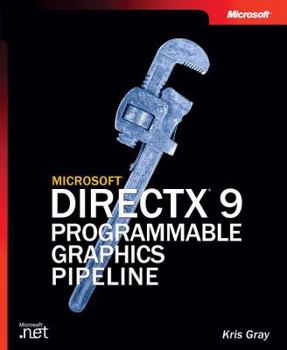Microsofta Directxa 9 Programmable Graphics Pipeline
Learn how to use programmable shaders in the DirectX 9 graphics pipeline and deliver awesome 3-D graphics to your animations, games, and other multimedia applications. This book distills hundreds of... This description may be from another edition of this product.
Format:Paperback
Language:English
ISBN:0735616531
ISBN13:9780735616530
Release Date:June 2003
Publisher:Microsoft Press
Length:453 Pages
Weight:2.20 lbs.
Dimensions:1.3" x 7.4" x 9.0"
Customer Reviews
3 ratings
Shaders and shader programming
Published by Thriftbooks.com User , 19 years ago
As of this writing, there doesn't seem to be a real reference manual for HLSL and the shader assembly language. This book makes a good effort at filling that role, however. The graphics programmer is likely to find this very useful. It integrates C application code with shader examples. It also discusses on-the fly compilation, use of resources for shader source code, the relationships between vertex and pixel shaders, texture samplers, and 'techniques' for pulling all the pieces together. Performance programming gets some discussion, but isn't a central topic. Appendices specify the shader language in dryly formal terms, but the descriptive chapters make most language features very clear. The shader programming model is decidedly non-standard. A rendering program does not work at all like a C program. Yes, a C/C++ programmer will be able to follow a shader's internals easily enough. The problem, though, is that a C program is in charge of what data gets handled when. Everything in a rendering program is silently a callback, however. It's invoked by some execution engine that sequences the input and output data, and even synchronizes multiple (and almost invisible) threads of execution. The hardware rendering program also interacts strongly with the application running in the main processor, partly through "semantics", reflective "annotations", and various parameter-setting mechanisms. There is a huge amount of mechanism at work, and it gives the real meaning to the interacting programs on the host and graphics engine. That mechanism is described in a black-box way, what it does rather than how it works. I think I've reverse engineered the workings, enough for my purposes, but this book did not address my needs directly. Still, it's the best I've found. Real graphics programs, like games and scientific visualization, are much more than lines and circles. This book, with its examples, will surely help the beginner acquire a working knowledge. //wiredweird
Does what the title says
Published by Thriftbooks.com User , 20 years ago
If you want what any professional game programmer would expect from this book, buy it - it does exactly that. It isn't a CG specific book and isn't aimed at C# programmers, but you wouldn't expect it to be. It's reasonable documentation and tutorial material for writing shaders.
misunderstood book
Published by Thriftbooks.com User , 20 years ago
This is not a book for learning DirectX. Please read the title and book description before purchasing to understand what you're getting. This is a book specifically about the DX9 PROGRAMMABLE GRAPHICS PIPELINE. If you're interested in programming pixel shaders and vertex shaders and using MS's HLSL, then consider this book. It's not a C# book (nor should it be), it's a reference material for the programmable pipeline. As far as free stuff goes, well, the DirectX SDK is free, so give me a break. Everyone just has to have everything free... people should write books for you for free too? Maybe you'd like to paint my house for free? Don't tell me you're like MS too?





